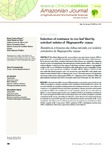Please use this identifier to cite or link to this item:
http://www.alice.cnptia.embrapa.br/alice/handle/doc/1003111| Title: | Induction of resistance to rice leaf blast by avirulent isolates of Magnaporthe oryzae. |
| Authors: | FILIPPI, M. C.  SILVA, G. B. da   SILVA-LOBO, V. L. da   VIANA, H. F.   CORTES, M. V. de C. B.   PRABHU, A. S.   |
| Affiliation: | MARTA CRISTINA CORSI DE FILIPPI, CNPAF; GISELE BARATA DA SILVA, UFRA; VALACIA LEMES DA SILVA LOBO, CNPAF; HERICA FERNANDES VIANA, bolsista CNPAF; MARCIO VINICIUS DE C BARROS CORTES, CNPAF; ANNE SITARAMA PRABHU, CNPAF. |
| Date Issued: | 2014 |
| Citation: | Revista de Ciências Agrárias, Belém, PA, v. 57, n. 4, p. 388-395, out./dez. 2014. |
| Description: | Rice blast (Magnaporthe oryzae) disease can cause losses of up to 100% in grain production. A sustainable management should consider alternative control measures. In the present work, biotic resistance induction to blast disease was studied by comparing disease severity and quantifying some pathogenesis-related proteins (PRPs). Rice plants of cultivars Metica-1 and Cica-8 were sprayed with biotic resistance inducers (incompatible isolates of M. oryzae) 48 h before inoculation with challenging isolates (compatible isolates of M. oryzae) under greenhouse conditions. For both cultivars, Metica-1 and Cica-8, the area under the disease progress curve was reduced by more than 80% when plants were induced with avirulent isolates of Magnaporthe oryzae. The biotic inducers also promoted an increase in the activity of peroxidase (POX), β-1.3-glucanase (GLU), chitinase (CHI), and phenylalanine ammonia-lyase (PAL). Systemic expression of resistance was also observed. |
| Thesagro: | Arroz Oryza sativa Doença de planta Brusone Pyricularia oryzae |
| DOI: | http://dx.doi.org/10.4322/rca.1673 |
| Type of Material: | Artigo de periódico |
| Access: | openAccess |
| Appears in Collections: | Artigo em periódico indexado (CNPAF)  |










